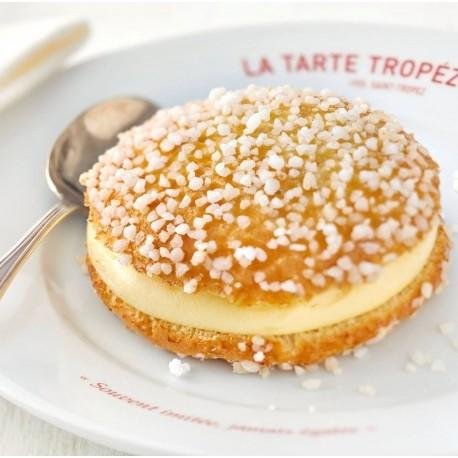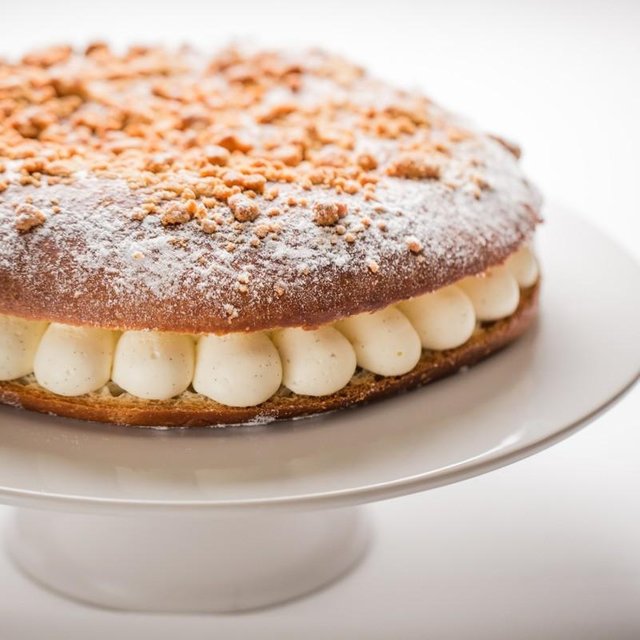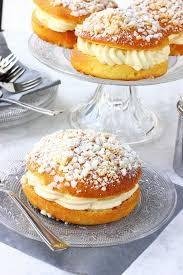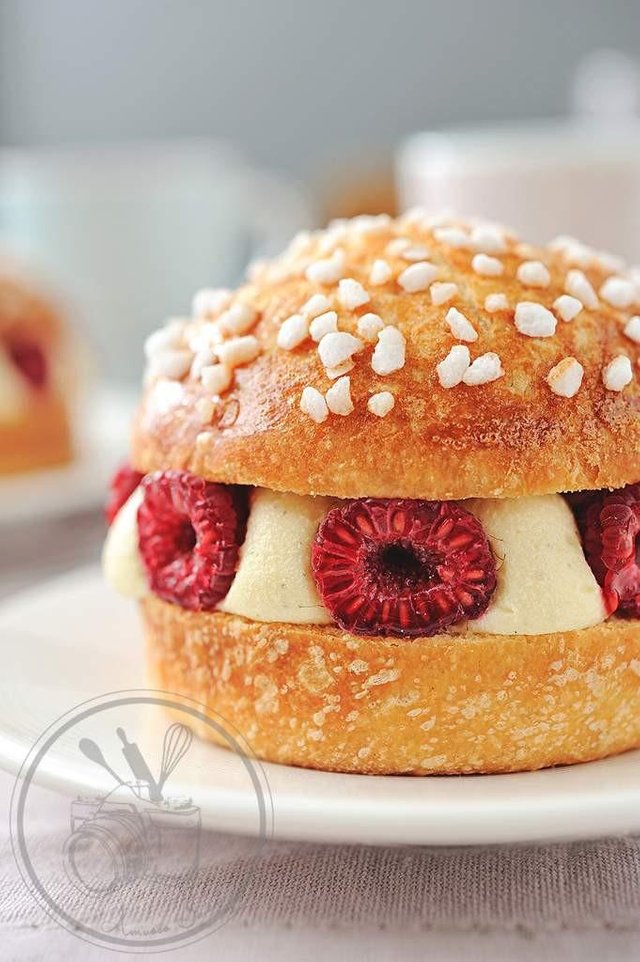Stars of pastry #13 – The Saint-Tropez pie
The Saint-Tropez pie

Is a cake made from a sugar brioche, sliced in half at its waist, and topped with a mixture of two creams (custard and whipped cream), a recipe of family origin of pastry chef Alexandre Micka. The recipe is filed and secret.
History
Arrived in Provence in 1952, Alexandre Micka, a pastry chef of Polish origin, decided to open a pastry bakery in Saint-Tropez. He brought from Poland the recipe for a brioche cake with the cream of his grandmother that he sells in his pastry. In 1955, the film of Roger Vadim, And God ... created the woman is shot in Saint-Tropez. Alexandre Micka was responsible for making the meals for the whole team. He presents his pie. Brigitte Bardot suggests that she name it "pie de Saint-Tropez". The pastry chef opted for "tropezienne pie". In the process, he filed the trademark and the patent of manufacture.

The restaurant and shops "La Tarte Tropézienne2" still exists in Saint-Tropez and along the Côte d'Azur.
Ingredients

The Saint-Tropez is a brioche dotted with granulated sugar which is filled with a mixture of butter cream and custard, possibly flavored with orange blossom water or, more rarely, rum. Since the mid-2000s, the technique of making pastry cream has been automated.
Recipe
This recipe is a little bit long and complex but it is a delight 😊
###Ingredients
The cake
• 2 1/2 teaspoons active dry yeast
• 1/3 cup (80 milliliters) warm whole milk
• 2 cups (272 grams) all-purpose flour
• 3 tablespoons sugar
• 2 large eggs, at room temperature, lightly beaten
• 1/2 teaspoon fine sea salt
• 2 teaspoons dark rum or kirsch (optional)
• 1 teaspoon pure vanilla extract
• 7 tablespoons (3 1/2 ounces; 99 grams) unsalted
butter, at room temperature
The filling
• 1 1/2 cups (360 milliliters) whole milk
• 4 large egg yolks
• 1/3 cup (67 grams) sugar
• 1/4 cup (32 grams) cornstarch
• Pinch of fine sea salt
• 1 tablespoon pure vanilla extract or 1 tablespoon
orange-flower water, plus 1 teaspoon pure
vanilla extract
• 3/4 stick (85 grams) unsalted butter, cut into bits,
at room temperature
• 1/4 cup (60 milliliters) very cold heavy cream
• 1 large egg, for glazing
• Pearl sugar or crushed sugar cubes, for finishing
Préparation
The cake
Put the yeast in a small bowl and pour over the warm milk. Allow the yeast to stand for a couple of minutes, until it’s fully dissolved; it might or might not bubble.
Put the flour and sugar in the bowl of a stand mixer fitted with the paddle attachment. Mix at low speed to blend the dry ingredients, then scrape in the yeast mixture and beat just to distribute it; you’ll have a shaggy mix. Keep the mixer spinning on low and add the eggs in a slow stream, then beat in the salt, rum or kirsch, if you’re using it, and vanilla. Increase the mixer speed to medium and beat, scraping down the bowl occasionally, for 5 to 8 minutes. The dough will start off rough and pockmarked, then it will pull into strands as the mixer spins and, finally, it will be smooth and form a ball.
Check the butter (soft but not oily). If it’s not soft, smear it across a work surface with the heel of your hand. Up the mixer speed to medium-high and toss in the pieces of butter a couple at a time. Keep mixing after the last bit of butter goes in until you’ve got a dough that forms a ball around the paddle, another 8 to 10 minutes.
Turn the dough out into a large bowl, then cup your fingers under the dough, lifting it and letting it slap down into the bowl again as you work your way around the bowl; when you’ve come full circle, you should have a nice, smooth, somewhat flattened ball of dough. Cover the bowl tightly with plastic film and put it in a warm place (70° to 75° F) until it rises to approximately double its original volume, 2 to 3 hours.
When the dough has risen, deflate it, using that same lift-and-drop method, cover the bowl tightly again and put it in the freezer for 30 minutes to arrest the dough’s development. Then transfer it to the refrigerator and chill for another 2 hours. (The dough can be refrigerated for up to 2 days.)
About an hour before you’re ready to bake, line a baking sheet with parchment paper or a silicone baking mat. Remove the bowl from the refrigerator and turn the dough out onto a lightly floured work surface. Gently pat the dough down, lightly flour the top and roll it into a 10-inch circle. Don’t worry about it being exactly 10 inches; concentrate on getting it round and almost that diameter, or smaller. Slide the dough onto the baking sheet, cover with a piece of plastic film -- don’t press down on it -- and let the dough rest in a warm place for 1 hour.
To bake the cake: About 20 minutes before you’re ready to bake, center a rack in the oven and preheat the oven to 400 degrees F. Lightly beat the egg and add a splash of cold water to it. Brush the top of the dough with the egg wash and sprinkle over the pearl or crushed sugar, patting it down lightly so that it sticks. Be generous with the sugar -- you want to pretty much cover the top.
Slide the baking sheet into the oven and immediately turn the oven temperature down to 350° F. Bake the cake for 20 to 25 minutes, rotating the sheet after 10 minutes, or until it is golden brown on both the top and bottom. Transfer the cake to a cooling rack and let it come to room temperature.
When you’re ready to fill the cake, whip the heavy cream until it holds firm peaks.
The filling
Bring the milk to a boil in a medium saucepan.
Whisk the yolks, sugar, cornstarch and salt together in a medium bowl. Whisking constantly, drizzle in one quarter of the hot milk. When the yolks are warm, add the rest of the milk in a steadier stream. Pour the mixture into the pan, return the pan to medium heat and, whisking vigorously, bring back to a boil. Keep at a boil, still whisking, for 1 to 2 minutes, making sure to get your whisk into the corners of the pan. Scrape the pastry cream into a bowl, add the vanilla and allow it to sit for 10 minutes at room temperature.
Add the bits of butter to the pastry cream a couple pieces at a time, whisking to incorporate. Press a piece of plastic film against the surface of the cream and chill for at least 2 hours, or, to speed up the chilling, put the bowl in a larger bowl filled with ice cubes and cold water and whisk until cold, then refrigerate until ready to fill the cake.
Remove the pastry cream from the refrigerator and whisk to loosen it. Stir a little of the whipped cream into the pastry cream, then fold in the rest of the whipped cream with a flexible spatula.
Finish
Using a long serrated knife and a very gentle sawing motion, cut the cake horizontally in half (it’s good to have the bottom layer a little thicker than the top). Put the bottom layer on a cake plate. Spread the filling over it, leaving a slim border bare, and replace the top of the cake, jiggling it slightly to settle it into the cream. Chill the cake for at least 1 hour, or for up to 8 hours. The filling needs to set in the refrigerator and the cake should be served cold.

hmmmmm yummy
Indeed, the recipe is a little bit long and complex but i want to try it. :D
Very tasty and alluring.
lovely food history...thanks for sharing
Very testy & spoongy.Love it
Very good post.

and very useful.
I have Resteem and Upvote your article for progress and forward together.
Steemit
I've just finished my lunch and, oh look, I'm hungry again.
its very tasty
delicious and yuummyyyy 😍
Oh its delicious @indesta120282